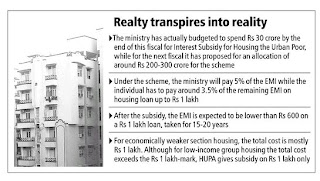
The problem with such schemes is that it does not fully recognize the reality of the housing market among the urban poor. Here are a few reasons
1. A large proportion of those likely to avail of these loans and live in housing units costing around Rs 1 lakh are seasonal migrants and those with flexible (both location and activity) occupations. For these people, house ownership, with its attendant debt repayment obligations, anchors them to the area and prevents them from seeking out their most optimal livelihood opportunities.
2. It also fails to acknowledge the reality that a significant proportion of the owners of these houses are not going to remain permanently poor as to prefer being locked into these dwelling units for more than 15 years. As their incomes improve, their aspirations would increase, and they would seek out larger and better dwelling units in other locations.
3. Very few urban poor own land, and therefore the major share of the spending will be in government's economically weaker sections (EWS) housing colonies. Further, even among those who claim to own lands, a significant proportion are likely to be encroachers on government properties, and such houses only add to the unplanned growth.
4. The fundamental challenge with urban housing, especially for the poor, is that of providing an adequate and constantly increasing supply of dwelling units, which accommodates the supply and demand in a market where people are constantly moving into and out of the city, with a net positive inward migration. The need of the hour is therefore to provide shelter to those migrating to cities in search of livelihoods, and not provide ownership of homes to them.
5. Onwership also provides numerous distortions. The lure of houses with market valuation three to four times the EMI cost, and the attraction of selling them and making a quick buck draws in poor people from the urban agglomerations and neven nearby villages. With the stakes being very high, the allotment process is rarely ever transparent and invariably gets politicised. It is commonplace to find a large proportion of these houses having been sold off and the original beneficiary ending up where he started.
There is a world of difference between owning a house and renting one. The economic consequences of this difference are profound and has deeper implications for any housing policy for the urban poor. In view of the aforementioned reasons, a more appropriate model would be to use this ISHUP scheme to construct housing colonies for the urban poor, and then rent it out to the applicants based on a seniority list of registered applicants. The EMI payment would equate to the rent. The allottees can be offered the incentive of ownership on completion of a specified period of habitation. Private developer too can be incentivized to enter this market by structuring different models. A more specific discussion of the different models is available here.
Ideally, these programs can be financed in a anumber of innovative ways of structured financing. One example is to raise money for construction by floating 15-20 year Housing Bonds, which can be serviced by escrowing the rent and subsidy payments and then reinvesting the amount remaining after payment of the dividends.
No comments:
Post a Comment